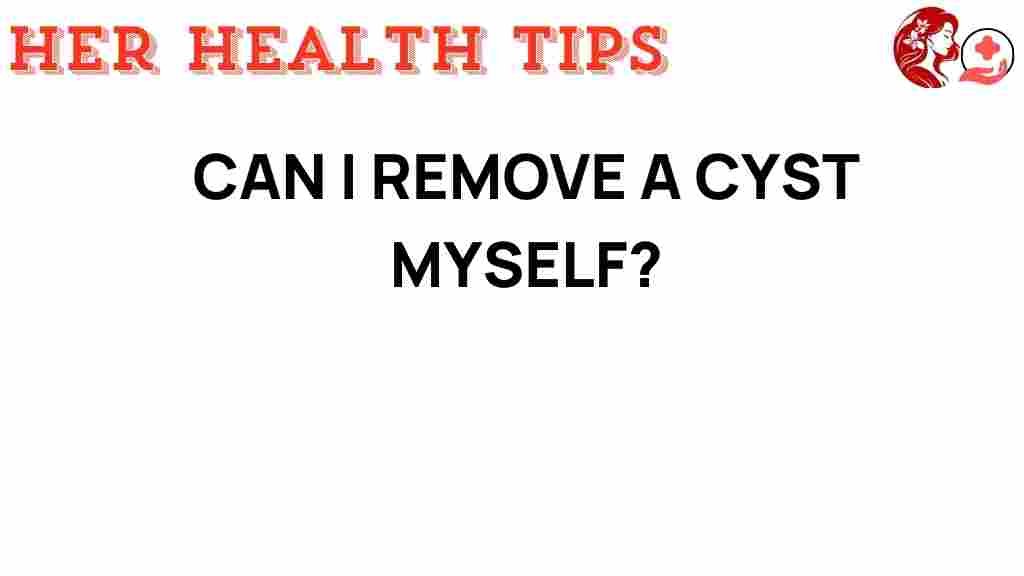The Risks and Realities of Self-Removing a Cyst: What You Need to Know About Cyst Removal
Cysts are common skin conditions that can occur anywhere on the body. While many people may consider cyst removal at home, it’s essential to understand the associated health risks and the importance of proper medical advice. This article explores the realities of self-removing a cyst, safety concerns, and effective treatment options to maintain skin health.
Understanding Cysts
A cyst is a closed sac-like structure filled with fluid, air, or other substances. They can vary in size and can be found on various parts of the body, including the face, neck, back, and scalp. Some common types of cysts include:
- Epidermoid cysts
- Pilar cysts
- Sebaceous cysts
- Ganglion cysts
- Breast cysts
While most cysts are benign and don’t cause harm, they can lead to discomfort, infection, or cosmetic concerns, prompting individuals to consider self-care options.
Risks of Self-Removing a Cyst
Self-removing a cyst might seem tempting, especially when seeking immediate relief. However, several health risks come with this decision:
- Infection: Breaking the skin can introduce bacteria, leading to infections that may require antibiotics or further medical intervention.
- Scarring: Improper removal techniques can result in unsightly scars or skin damage.
- Incomplete removal: If the entire cyst wall isn’t removed, it may recur, leading to repeated attempts at removal.
- Bleeding: Cutting into a cyst can cause bleeding, especially if blood vessels are involved.
- Pain: Self-removal can be painful and uncomfortable, potentially leading to further complications.
Why Seek Medical Advice?
Before considering cyst treatment at home, it’s crucial to consult a healthcare professional. A doctor can provide a proper diagnosis and recommend the best course of action. They may suggest:
- Observation: Monitoring the cyst if it isn’t causing problems.
- Minimally invasive removal: Using sterile techniques to safely remove the cyst.
- Injection: In some cases, injecting medication to reduce the cyst size may be suggested.
Always prioritize your skin health and overall well-being by seeking professional guidance.
Step-by-Step Process for Safe Cyst Removal (If Advised)
If you have received medical advice to attempt cyst removal at home, follow these steps carefully to ensure safety:
1. Prepare Your Tools
Gather the following supplies:
- Sterile needle or scalpel
- Alcohol wipes
- Gloves
- Antiseptic ointment
- Bandages
2. Clean the Area
Use alcohol wipes to thoroughly clean the area around the cyst. This step is crucial to prevent infection.
3. Wear Gloves
Put on sterile gloves to maintain hygiene and reduce the risk of contamination.
4. Incise the Cyst
Use a sterile needle or scalpel to make a small incision at the top of the cyst. Be careful not to cut too deeply.
5. Drain the Cyst
Gently press around the incision to allow the contents of the cyst to drain out. Avoid squeezing too hard, as this can cause damage.
6. Remove the Cyst Wall
If you can see the cyst wall, carefully remove it using your sterile tool. Ensure that you extract the entire wall to prevent recurrence.
7. Clean and Bandage
After successfully removing the cyst, clean the area again with alcohol wipes and apply antiseptic ointment. Cover it with a sterile bandage.
Post-Removal Care
After cyst removal, follow these self-care tips:
- Keep the area clean and dry.
- Change the bandage daily or if it becomes wet.
- Watch for signs of infection, such as increased redness, swelling, or pus.
- Avoid picking at the area to reduce the risk of scarring.
Troubleshooting Tips
If you experience complications after attempting self-removal, consider the following:
- Infection: If you notice symptoms of infection, such as fever or increased pain, contact your healthcare provider immediately.
- Persistent cyst: If the cyst returns or you experience discomfort, consult a professional for further evaluation.
- Scarring concerns: If scarring occurs, dermatological treatments may help improve the appearance.
Home Remedies for Cyst Management
While home remedies are not a substitute for professional medical care, some methods may help manage cysts or alleviate discomfort:
- Warm compress: Applying a warm compress can help reduce inflammation and promote drainage.
- Tea tree oil: Known for its antibacterial properties, tea tree oil can be applied topically to help with cysts.
- Aloe vera: This natural remedy can soothe the skin and may aid in healing.
Always perform a patch test before applying any home remedy to ensure you do not have an allergic reaction.
Conclusion
While the idea of self-removing a cyst may seem appealing, the associated health risks and potential complications make it a risky endeavor. Prioritizing medical advice is crucial to ensure your skin health and safety. If you are considering cyst removal, consult with a healthcare professional for the best treatment options. Remember that self-care is essential, but it should never replace proper medical guidance.
If you’re looking for more information on skin health, check out this comprehensive guide on maintaining healthy skin. And for further reading on cyst management, visit this resource.
This article is in the category Conditions and created by HerHealthTips Team
